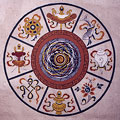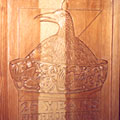Commonly used symbols in Bhutan and their significance
DRAGON (DRUK)
Bhutan, often referred to as the Druk Yul, or the Land of the Thunder Dragon takes its name from the druk or the Thunder Dragon, a mythical animal revered by the Bhutanese as the symbolic guardian of the country. Legend goes that Tsangpa Gyare Yesga Dorji (1161-1211) was consecrating a new monastery in Tibet when he heard the sound of thunder. Taking it to be the call of the dragon he named the monastery Druk and his school of religious thought came to be known as the Drukpa. When Bhutan was unified, by Shabdrung Ngawang Namgyel, a lama of the Drukpa school, it came to be known as Druk Yul or the Land of the Thunder Dragon.
The dragon can be found on Bhutan’s national flag, the royal crest and in many paintings in temples and buildings. In fact the word druk has come to be synonymous with all things Bhutanese – it is the name used by the National Airlines; it is also the trade mark for fruit juices, jams and other commodities.
In the National Flag, the upper part of the flag’s golden yellow colour represents the secular power of the king, the lower orange part symbolises the Buddhist religion and the white dragon represents the country of Bhutan itself – its purity; the jewels held in its claw stand for the wealth and perfection of the country.

ROYAL CREST (DRUK KHATAP)
The official seal or Royal Crest of Bhutan has two dragons, and in between in the centre is the crossed dorje (vajra/thunderbolt). The sacred jewel at the top of the crest signifies the supremacy of the sovereign in the Buddhist Kingdom of Bhutan.
The dorje jadram or ‘Crossed Thunderbolt’ (vajra) at the centre symbolises the harmonious relationship between traditional customs of spiritual law and modern authority.
The two male and female thunder dragons (druk) guarding the crossed thunderbolts represent the two deities protecting the country’s religion and people from inimical outside forces.

EIGHT AUSPICIOUS SIGNS (TASHI TAGYE)
In a certain configuration, the eight auspicious signs represent the different parts of Lord Buddha’s body (viz. the vase of immorality represents the throat, the lotus represents the tongue, the fishes represent the eyes and so on). The signs are extensively used as decorations in Bhutan. They are painted on the ceilings and pillars in buildings and also carved in metal or wood. They also feature on the reverse of the tikchung coin in circulation in Bhutan.
- The Treasure Vase (bumpa) symbolises the contents of the Buddhist doctrine, treasures that will overcome all desires on the part of its believers.
- The Endless Knot (pay-yap or drami) stands for depth of mind, thinking and love.
- The Victorious Banner (gyaltshen) proclaims the victory of Enlightenment and Buddhism and virtue over vice.
- The Wheel of Law (khorlo) represents the propagation of the Buddha’s teachings – and as it moves symbolises that the Buddhist doctrines are alive and flourishing.
- The Golden Parasol (ser dhug) symbolises the authority of the Buddha’s teachings. Just as the parasol offers protection from the sun, the Dharma also protects people’s spirits from evil.
- The Golden Fish (sergi nya) keep their eyes wide open in spite of the water and they have knowledge of obstacles and objectives. Similarly, the Buddhist doctrine allows the faithful to act correctly in the world and achieve happiness and realisation of truth.
- The White Conch (dung kar): The sound of it signifies the propagation of the Buddhist doctrine and the reverberating sound of Dharma.
- The Lotus Flower (meto pema) connotes non-attachment. As the lotus is never stained with the mud in which it grows, so a pure conscience does not remain attached to samsara or life of this world.

FOUR HARMONIOUS SIBLINGS (THUENPA PUNZHI)
The fable of the four harmonious siblings is said to have been told by the Buddha himself to promote Buddhist virtues. The composition illustrates the harmonious relationship among four siblings (elephant, monkey, rabbit, and bird), and their co-operation with each other – the strong support the weak and they all unite together to make a tree grow.
THE TAG (TIGER),SINGHE (SNOW LION), CHUNG (GARUDA) AND DRUK (DRAGON)
The tag (tiger), singhe (snow lion), chung (garuda) and druk (dragon) can often be seen painted together outside buildings. These four animals bring good luck. Garuda, the mythical sun eagle – Vishnu’s vehicle (Vishnu is a Hindu divinity) is also owned by Vajrayana Buddhism and associated with Vajrapani. The famous Chinese pilgrim, Husan Tsang mentions that Vajrapani was connected with subduing the gigantic snake in Uddiyana. It is also believed that when the serpents came to listen to the Buddha’s sermons, it was Vajrapani’s duty to protect them from their mortal enemy, the garuda. To do so, Vajrapani assumed the shape of a garuda and is thus depicted on the top of the Prabhavalis of important Buddhist divinities.

THE SIX SYMBOLS OF LONG LIFE (TSHERING DRUKOR)
This image depicts the symbols of longevity and brings good luck. They are:
- The long edged rocky cliff;
- The long spring/river;
- The long leafed tree;
- The old ascetic (depicting long human life)
- The long necked bird;
- The long horned deer of long life

THE RAVEN (MAHAKALA)
This represents the deity Gonpo Tarodonchen (Mahakala with a raven’s head) one of the most important guardian deities of Bhutan.
Gallery
YOUR VIEWS
PRACTITIONERS: INDIA
Access 70,000+ practitioners in 2500+ crafts across India.
BIBLIOGRAPHY
10,000+ listings on arts, crafts, design, heritage, culture etc.
GLOSSARY
Rich and often unfamiliar vocabulary of crafts and textiles.
SHOP at India InCH
Needs to be written.





